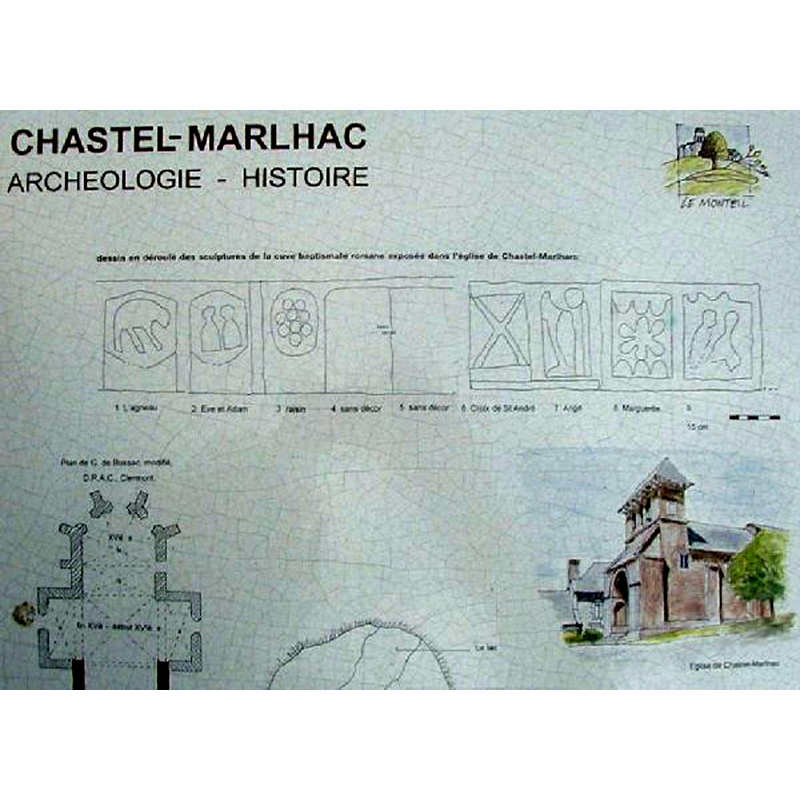Chastel-Marlhac

Image copyright © Denis Letemplier, 2008
Image and permission received (e-mail 10/8/2003)
Results: 10 records
B01: design element - architectural - arcade
B02: animal - mammal - lamb?
B03: human figure - 2 - Adam and Eve? - Annunciation?
B04: symbol - fruit - grapes
B05: blank
B06: symbol - cross - saltire? or "X" motif?
B07: human figure - angel?
B08: design element - motifs - floral - daisy?
B09: human figure - 2
INFORMATION
FontID: 08563CHA
Object Type: Baptismal Font1
Church/Chapel: Eglise prieuriale des bénédictines; Sainte-Madelaine, St-Victor [origin unknown]
Church Patron Saints: St. Mary Magdalene, St. Victor
Country Name: France
Location: Cantal, Auvergne-Rhône-Alpes
Directions to Site: Located on the D36, in the Commune de Le Monteil, 4-5 km ESE of Saignes, in the canton de Saignes
Font Location in Church: inside the church since 1977 [earlier at a crossroads - cf. Font notes]
Century and Period: 11th - 13th century, Romanesque
Cognate Fonts: This font may share some related motifs with the font at Mauriac
Credit and Acknowledgements: We are grateful to M. Denis Letemplier for his images of the font and the church interior and for the Palissy reference
Font Notes:
Click to view
Listed as an early baptismal font in the web version -augmented- of the Églises romanes de Haute Auvergne (tome 1, pp. 45-50) [cantalroman.free.fr/Histoire/quotid.htm]. Described in Le Guillou (1993) as a baptismal font which, though badly damaged now, may have been originally ornamented with an iconographic program similar to the one at Mauriac [cf. Index entry]. Le Guillou (ibid.) admits that there remains little discernible evidence of the program, only three of the arches are visible and the images inside the arches are almost oblterated: perhaps an unidentified animal that might correspond to either the Agnus Dei of the Mauriac font, or perhaps the ox of the Tetramorph on the same font; the next arch, which appears to contain two facing figures, could correspond to the Annunciation or the Baptism of Christ on the Mauriac font; the next motif, adds Le Guillou, might be the only element left of the four symbols of the Evangelists; the following four arches are illegible, perhaps never carved if the font was meant to go against a wall; the next arch, in very poor shape, could represent the scene with St. Michael and the Devil; the next two arches could have made up one scene but no evidence remains [NB: the whole description of this program is presented by Le Guillou as a hypotheses and he recognises that there is no evidence to support it in what is left of the damaged program. Eppur...]. The origin of this font is not known. Le Guillou (ibid.) informs that it was found exposed to the elemts and being put to low uses ["ils se sont de long temps trouvés en plein air, réservés à un usage domestique des plus communs"] as well as having been willfully damaged ["martelés intentionnellement"], perhaps to hide the sacred function of the object ["destiné à cacher l'origine sacrée de l'objet"]. A panel at the church identifies nine panels on the basin sides, of which only two are totally without carving [and may perhaps be the sides which were meant to go against a wall; the following is the identification provided in the said panel [L->R, starting at the quadruped]: 1)lamb; 2)Adam & Eve; 3)bunch of grapes; 4-5)blank panels; 6)saltire/St Andrew's cross; 7)daisy; 8)there is no caption for this panel, although it appears to show two human figures. The arches or windows in which the program is housed are very irregular, some pointed, some round, some square, as well as being very irregular in size. It is obvious that, even in its best day, the execution of this program was not a fine piece of work, but the output of a very limited carver. The PALISSY index identifies the stone as tuff [being in Auvergne probably of volcanic formation] and describes the program thus: six-point star; animal-shaped motif; quadruped; two silhouettes, possibly human but without extremities; two unidentified motifs; it gives the iconography as ornamental: star, St. Andrew's cross, animal motif, grapes, human figure; it dates the object to the medieval period and informs that it used to serve as the base for a cross at a crossroads of rural road no. 10 and the communal road 1 linking Le Monteil with Vrebet; it also suggests that it may have been a baptismal font or a holy-water stoup and therefore was taken to the church in 1977 [source: PALISSY, reference no. IM15000102, rédacteur Brunet Marceline, Inventaire général, 1994 -- www.culture.fr/public/mistralpalissy]. Noted in Moulier (1999).
MEDIUM AND MEASUREMENTS
Material: stone, tuff (volcanic?)
Number of Pieces: one
Font Shape: polygonal (unmounted)
Basin Interior Shape: round
Basin Exterior Shape: polygonal
Drainage Notes: a/p description in PALISSY
Diameter (includes rim): 100 cm
Basin Total Height: 63 cm
Font Height (less Plinth): 63 cm
Notes on Measurements: PALISSY, reference no. IM15000102, rédacteur Brunet Marceline, Inventaire général, 1994 -- www.culture.fr/public/mistralpalissy]
REFERENCES
France, Ministère de la culture, Inventaire Général, Palissy (France, Ministère de la culture), France, Ministère de la culture. Accessed: 2003-09-12 00:00:00. URL: http://www.culture.fr/public/mistral/palissy.
Le Guillou, Jean, "Essai d'interprétation des sculptures de la cuve baptismale romane de l'église paroissiale de Mauriac", 55, 1, Revue de la Haute-Auvergne, 1993, pp. 76-88; p. 86-88
Moulier, Pierre, Églises romanes de Haute-Auvergne: contributions à un iventaire regional, Nonette: Éditions Créer, 1999


